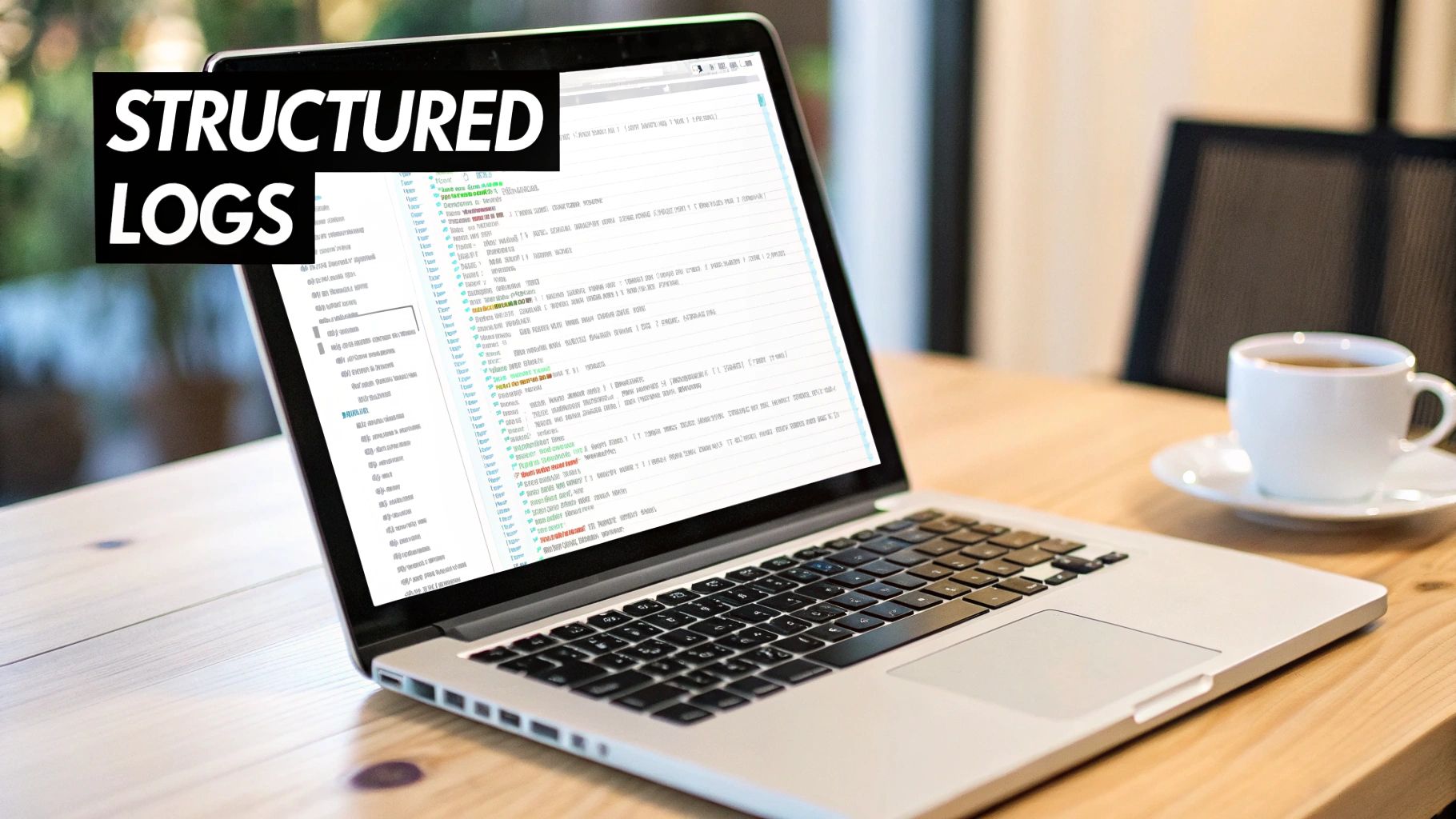 23.07.2025
23.07.2025
 23.07.2025
23.07.2025

In the world of Laravel web development, logs are often treated as an afterthought-a repository for cryptic error messages we only consult when things go seriously wrong. But what if we viewed them as a proactive tool for enhancing reliability, simplifying debugging, and gaining deep insights into our application's health? Effective logging is not just about capturing exceptions; it's a discipline that separates fragile applications from robust, maintainable, and well-organised systems.
Adopting a strategic approach transforms logging from a reactive chore into a powerful business asset. Mastering this skill is fundamental to delivering high-quality, dependable digital solutions. This guide moves beyond the basics, presenting eight critical logging best practices designed to elevate your Laravel projects. We will explore actionable strategies, complete with practical code examples, to help you build applications that are not only functional but also transparent, secure, and resilient. Prepare to turn your application logs from a cluttered archive into a clear, insightful narrative of your system's performance and behaviour. This list will show you precisely how to implement each practice for immediate improvements.
Implementing a structured hierarchy of log levels is the foundational step in any robust logging strategy. This is not just about recording events; it’s about categorising them by severity to create a signal from the noise. By assigning the correct level to each log message, you transform a chaotic stream of data into an organised, searchable, and actionable resource. This is one of the most crucial logging best practices because it directly impacts your ability to debug efficiently and respond to incidents promptly.

In Laravel, which adheres to the PSR-3 standard, you have eight distinct levels at your disposal: DEBUG, INFO, NOTICE, WARNING, ERROR, CRITICAL, ALERT, and EMERGENCY. Each serves a unique purpose, allowing you to filter logs based on the environment. For instance, a development environment might log everything down to the DEBUG level for granular troubleshooting, while a production environment may be configured to only capture WARNING and above to minimise performance overhead and focus on significant issues.
Without proper log levels, all events, from a simple user login (INFO) to a critical database connection failure (CRITICAL), are treated with equal importance. This makes it nearly impossible to identify urgent problems. Imagine sifting through thousands of routine informational messages to find the one error that brought your application down. Adopting distinct levels allows you to set up alerts for high-severity events and quickly filter logs to diagnose specific types of problems.
Key Insight: The strategic use of log levels is what separates a passive, historical record from an active, real-time diagnostic tool. It empowers developers and operations teams to prioritise their attention where it's needed most.
To effectively implement log levels in your Laravel application, consider the following:
Configure Environment-Specific Levels: In your .env file, set LOG_LEVEL=debug for local development and LOG_LEVEL=warning or LOG_LEVEL=error for production. This simple change drastically cleans up your production logs.
Use ERROR for Handled Exceptions: Log an ERROR when your application catches an exception but can continue running. This flags a significant problem that needs investigation without indicating a total system failure.
Reserve DEBUG for Development: Use Log::debug() to trace variable states or complex logic flows. These messages are invaluable during development but are typically too verbose for production.
Utilise INFO for Key Business Events: Log user registrations, order placements, or major state changes at the INFO level. This creates a clear audit trail of normal application activity.
Moving beyond simple text-based logs to a structured, machine-readable format like JSON is a transformative step. Structured logging involves creating log entries as key-value pairs, standardising fields such as the timestamp, log level, and service name. This approach turns your logs from ambiguous strings into a rich, queryable dataset, a cornerstone of modern logging best practices. It allows for powerful filtering, aggregation, and analysis, which is simply not feasible with plain text.

Instead of a log message like "User 123 failed to update profile", a structured log captures this event as a JSON object: { "message": "Profile update failed", "user_id": 123, "level": "error" }. This consistency is championed by platforms like the Elastic Stack and Datadog because it enables sophisticated observability. Tech giants like Uber and Airbnb rely on structured logging to maintain visibility across their vast microservices architectures, demonstrating its scalability and power.
Unstructured logs are difficult for machines to parse reliably. Searching for a specific user's activity or isolating all errors of a certain type requires complex and fragile string matching. Structured logging makes this trivial. You can easily query for all logs where user_id == 123 or level == 'error'. This precision is critical in complex systems, especially when tracing a request as it flows through multiple services, making debugging faster and more accurate.
Key Insight: Structured logging treats logs as data, not just text. This fundamental shift unlocks advanced analytics, automated alerting, and deeper operational insights that are impossible to achieve with inconsistent, free-form log messages.
To effectively implement structured logging in your Laravel application, consider the following:
Add Contextual Information: Always include relevant data like the user_id, session_id, or request_id in your log's context array. Laravel's Log facade makes this simple: Log::info('User logged in', ['user_id' => $user->id]);.
Use Correlation IDs: For microservices, pass a unique correlation ID (e.g., X-Request-ID) with each request and include it in every log entry. This allows you to trace a single user action across multiple distributed services.
Maintain Consistent Field Names: Standardise your key names across all applications and services. For example, always use user_id, not userId or userIdentifier. This consistency is crucial for centralised logging platforms.
Configure a JSON Formatter: In Laravel, you can easily configure a logging channel to use a JSON formatter, such as Monolog's JsonFormatter, to automatically convert all log entries into a structured format.
One of the most critical, yet often overlooked, aspects of a logging strategy is the scrupulous protection of sensitive data. Writing information such as passwords, API keys, personal identifiable information (PII), or financial details into log files creates a significant security vulnerability. If these logs are ever compromised, the exposed data can lead to severe financial, reputational, and legal consequences. This practice is a cornerstone of modern logging best practices, essential for maintaining security and complying with regulations like GDPR.

In Laravel, it's easy to accidentally log the entire request payload, which might contain user credentials or other sensitive fields. For example, logging an entire Illuminate\Http\Request object during an exception will include all submitted form data. A robust approach involves implementing strict policies and technical controls to automatically filter, mask, or tokenize this data before it is ever written to a log file, a principle central to frameworks like the OWASP Security Guidelines.
Logging sensitive data turns a valuable diagnostic tool into a security liability. A single data breach originating from log files can undermine customer trust and result in hefty fines under data protection laws. For instance, healthcare applications must adhere to HIPAA compliance by masking patient data, and financial institutions use tokenization to protect transaction details. Failing to implement these safeguards is not just poor practice; it's a direct threat to your business and your users' privacy. Proper data handling in logs is a fundamental part of a comprehensive data security checklist.
Key Insight: Your logs should tell you what happened, not who it happened to. The goal is to retain diagnostic value without creating a treasure trove of sensitive information for potential attackers.
To prevent sensitive data from contaminating your logs, implement these measures in your Laravel application:
Configure Parameter Filtering: In config/logging.php, you can specify request parameters to be masked. Laravel automatically filters fields like password and password_confirmation, but you should extend this list to include any other sensitive fields specific to your application (e.g., api_key, credit_card_number).
Create a Centralised Sanitisation Service: Develop a dedicated service or helper function that sanitises arrays and objects before logging. This ensures consistent data scrubbing across your entire application.
Use Hashing for Identifiers: If you need to trace activity related to a specific piece of data (like an API key), log a hashed or tokenized version of it instead of the raw value. This allows for correlation without exposing the original secret.
Regularly Audit Your Logs: Periodically review your production logs to ensure no sensitive information is slipping through the cracks. Automated scanning tools can help detect common data patterns like credit card numbers or email addresses.
A log message without context is like a single sentence torn from a book; it might make sense on its own, but its true meaning is lost. Including contextual information in your logs transforms isolated events into a coherent narrative of what’s happening inside your application. This involves enriching every log entry with metadata like user IDs, session identifiers, and unique request IDs to provide a complete picture. This is one of the most powerful logging best practices for modern, complex systems, especially those built on microservices architectures.

In Laravel, you can automatically add context to all log messages within a specific request using Log::withContext(). For instance, placing Log::withContext(['request-id' => $requestId, 'user_id' => auth()->id()]); in a middleware ensures every subsequent log call in that request's lifecycle is automatically stamped with this crucial data. This eliminates repetitive code and guarantees consistency.
In a distributed system, a single user action might trigger a chain of events across multiple services. Without a shared identifier, like a correlation ID, tracing that user's journey is a near-impossible task. Contextual logs allow you to filter and aggregate data with precision. You can isolate all log entries for a specific user, trace a single failed request through your entire stack, or analyse the behaviour of a particular feature flag. This dramatically reduces the time it takes to debug issues, from minutes to seconds.
Key Insight: Context is what turns your logs from a simple event stream into a powerful diagnostic and observability tool. It allows you to ask specific questions about your system's behaviour and get clear answers.
To effectively add context to your Laravel logs, follow these strategies:
Implement Correlation IDs: Generate a unique ID at the entry point of your application (e.g., in a middleware) for each incoming request. Pass this ID in headers to downstream services and include it in every log message to trace a request across service boundaries.
Add Business Context: Include relevant business identifiers such as an order_id or customer_id. This helps you quickly find all logs related to a specific business transaction without needing technical identifiers.
Use Laravel's Context Processors: Leverage Laravel's logging configuration to add processors. These are callables that automatically inject information, like a request-id or Git commit hash, into every log record.
Include Environment Details: Automatically add the application environment (production, staging) and server hostname to your logs. This helps differentiate logs from various sources and quickly identify environment-specific issues.
As your application ecosystem grows beyond a single server or service, managing logs on individual machines becomes impractical and inefficient. Centralised logging addresses this by aggregating logs from multiple sources, such as different web servers, microservices, and infrastructure components, into a single, searchable platform. This approach provides a unified view of your entire system's behaviour, transforming disparate data streams into a coherent narrative. For any distributed system, this is one of the most vital logging best practices to adopt for comprehensive monitoring and cross-service debugging.
Popular solutions like the Elastic Stack (Elasticsearch, Logstash, Kibana), Splunk, or Graylog are built for this purpose. They enable you to ship logs from your various Laravel applications and their underlying servers to a central hub. Here, you can perform complex queries, create dashboards, and set up alerts that correlate events across your entire infrastructure, something impossible when logs are siloed on individual machines.
Without a centralised system, diagnosing an issue that spans multiple services requires logging into each machine, locating the relevant log files, and manually trying to piece together a sequence of events. This process is slow, error-prone, and often futile. Centralised logging gives you a holistic view, allowing you to trace a single user request as it travels from a web server through several microservices to a database, all from one interface. It’s the key to understanding the full picture, especially in complex, modern architectures.
Key Insight: Centralised logging turns your logs from isolated, local files into a powerful, system-wide event stream. It is the foundation for effective observability in any distributed or scaled application.
To effectively centralise your Laravel application logs, consider the following:
Choose the Right Stack: Select a logging platform that fits your scale and budget. The Elastic Stack is a powerful open-source option, while services like Papertrail or Datadog offer managed solutions that simplify setup.
Use a Dedicated Log Shipper: Install an agent like Fluentd or Filebeat on your servers. Configure it to tail your Laravel log files (storage/logs/laravel.log) and forward new entries to your central logging endpoint.
Standardise Log Formats: Ensure all your services log in a consistent JSON format, as discussed earlier. This makes parsing, indexing, and searching data in your centralised platform dramatically easier.
Monitor the Logging Pipeline: Keep an eye on the performance of your centralised logging system itself. Implement redundancy and use log buffering to handle network interruptions and prevent data loss.
Synchronous logging, where the application waits for each log entry to be written to its destination, can introduce significant latency. In high-traffic applications, this delay can become a critical performance bottleneck. Asynchronous logging solves this by decoupling the logging process from the main application thread, a fundamental technique among modern logging best practices. This approach queues log messages and processes them in the background, ensuring your application remains responsive and performant even under heavy load.
In Laravel, this can be achieved by using queue-based logging drivers or by wrapping an existing logging channel with Monolog's BufferHandler or AsyncAppender. The core principle is simple: your application fires off a log message and immediately continues its work, trusting a separate process or worker to handle the disk I/O or network request. This is particularly crucial for performance-critical operations, like those in high-frequency trading platforms or large-scale gaming applications handling millions of events per minute.
When every millisecond counts, forcing your primary execution thread to wait for a logging operation is unacceptable. A slow network connection to a remote logging service or a high-load disk could bring your entire application to a crawl. Asynchronous logging acts as a protective buffer, absorbing these I/O-bound tasks and preventing them from impacting the user experience. It transforms logging from a potential performance liability into a safe, non-blocking background task.
Key Insight: Asynchronous logging isn't just a performance optimisation; it's a resilience pattern. It isolates your application's core logic from the unreliability and latency of I/O operations, making your system more robust.
To effectively implement asynchronous logging in your Laravel application, consider these strategies:
Leverage Laravel Queues: Configure a dedicated queue for logging. This offloads the entire process to your queue workers, providing excellent separation and resilience.
Use Monolog's BufferHandler: Wrap your production logging channel (e.g., stack or daily) with the BufferHandler. This collects log records in memory and flushes them in a single batch, either when the buffer is full or when a record of a certain level (e.g., ERROR) is logged.
Monitor Your Queue Sizes: If using a queue-based approach, it's vital to monitor the queue length. A consistently growing queue indicates that your logging workers cannot keep up, a key consideration in a comprehensive DevOps adoption roadmap.
Configure Buffer Sizes Wisely: When using buffers, choose a size that balances memory usage against I/O frequency. A small buffer may not provide significant performance gains, while a very large one could consume excessive memory.
Without a proper management plan, log files can grow indefinitely, consuming valuable disk space and becoming unwieldy to manage and search. Establishing clear log retention and rotation policies is a critical practice that addresses this challenge directly. This involves systematically archiving, compressing, and eventually deleting logs, ensuring your system remains performant and your storage costs stay under control. This is one of the most important logging best practices for long-term system stability and compliance.
In Laravel, the default log channel is single, which writes to one large file. This is manageable for a short time, but production applications should use the daily channel, which automatically creates a new log file each day. This simple change is the first step towards a sustainable rotation policy. More advanced systems, popularised by tools like Logrotate on Linux or Elasticsearch's Index Lifecycle Management, build on this by introducing rules for size-based rotation, compression, and automated deletion.
Unmanaged logs present two significant risks: resource exhaustion and compliance failure. A runaway log file can fill a server's disk, causing the entire application to crash. Furthermore, many industries have strict regulatory requirements for data retention; for example, financial services might need to keep logs for seven years, while healthcare systems must adhere to HIPAA's secure data handling policies. A well-defined policy ensures you meet these obligations without hoarding unnecessary data.
Key Insight: Log retention isn't just about deleting old files; it's a strategic balance between operational needs, regulatory compliance, and storage costs. It transforms logging from a potential liability into a well-managed asset.
To implement effective retention and rotation policies in your Laravel application, consider these steps:
Align Policies with Requirements: Determine your business and legal needs first. An e-commerce site might retain operational logs for 90 days for trend analysis, while a banking app requires a much longer, compliant retention period.
Use the daily Log Channel: In your config/logging.php or .env file, set the default log channel to daily. You can also configure how many days of files to keep before they are automatically deleted using the days option.
Implement Compression: For logs that must be retained for long periods but are infrequently accessed, set up a cron job to compress older log files (e.g., using gzip). This dramatically reduces their storage footprint.
Monitor Disk Usage: Regularly monitor your server's disk space to ensure your rotation policies are working as expected and to prevent unforeseen outages.
Simply collecting logs is a passive activity; the real value lies in actively analysing them in real-time. Implementing automated monitoring and alerting on log patterns transforms your logs from a historical archive into a proactive defence mechanism. This approach involves using intelligent systems to parse log data, identify anomalies, and trigger alerts when predefined conditions are met. Adopting this strategy is one of the most impactful logging best practices as it shifts your team from reactively fixing breakages to proactively preventing them.
Modern log management platforms like Datadog or New Relic excel at this, allowing you to set up sophisticated rules that detect everything from a sudden spike in ERROR level messages to unusual authentication failure patterns. For instance, GitHub actively monitors for repeated failed login attempts from a single IP address to flag potential brute-force attacks. This real-time analysis enables rapid response to security threats and performance degradation, ensuring high service reliability.
Without automated monitoring, critical issues can go unnoticed for hours or even days, buried within millions of log entries. By the time a customer reports a problem, significant damage may have already occurred. Automated alerting ensures that the right people are notified the moment an issue arises. This is crucial for detecting performance bottlenecks, identifying emerging security threats, and maintaining a high level of application availability, directly impacting user satisfaction and trust.
Key Insight: Proactive monitoring and alerting turn your logging system into an early warning system for your application's health. It enables you to detect and resolve problems before they escalate and affect your users.
To effectively set up monitoring and alerting for your Laravel application, consider these steps:
Start with Simple, High-Value Rules: Begin by creating alerts for critical events, such as a surge in CRITICAL or EMERGENCY logs, or a complete absence of logs, which could indicate a service outage.
Implement Alert Severity: Differentiate between a WARNING (e.g., high memory usage) and a CRITICAL alert (e.g., database connection lost). Route high-severity alerts to tools like PagerDuty for immediate action, while lower-severity ones can go to a Slack channel for review.
Use Statistical Analysis to Reduce Noise: Instead of alerting on every single error, use thresholds and statistical deviations. For example, alert only if the error rate exceeds its normal baseline by 200% over a five-minute window. This helps to minimise alert fatigue from false positives.
Regularly Tune Your Rules: Your application and its normal behaviour will evolve. Review and adjust your alerting rules quarterly to ensure they remain relevant and effective.
To delve deeper into this topic, you can learn more about application performance monitoring and how it integrates with logging strategies.
| Item | Implementation Complexity 🔄 | Resource Requirements ⚡ | Expected Outcomes 📊 | Ideal Use Cases 💡 | Key Advantages ⭐ |
|---|---|---|---|---|---|
| Use Appropriate Log Levels | Medium - requires discipline and training | Low - standard logging frameworks support | Efficient log filtering and prioritized issue detection | Applications needing clear severity differentiation | Reduces noise, improves troubleshooting |
| Implement Structured Logging | High - requires setup and consistent field standards | Medium - increased log size and parsing tools | Enhanced log analysis, automated alerting | Systems needing machine-readable logs and automation | Better integration with log management tools |
| Avoid Logging Sensitive Information | Medium - policy enforcement and masking implementation | Low to Medium - additional filtering and audits | Improved security and compliance | Security-sensitive applications and compliant systems | Protects sensitive data, meets legal requirements |
| Include Contextual Information | Medium - requires metadata collection and propagation | Medium - added log volume and storage | Better traceability and root cause analysis | Distributed systems and microservices architectures | Enables end-to-end request tracing |
| Implement Centralized Logging | High - infrastructure setup and maintenance | High - centralized storage and processing | Unified log view, cross-service correlation | Large distributed environments and multi-service setups | Simplifies log management, enables comprehensive monitoring |
| Use Asynchronous Logging | Medium to High - involves async mechanisms and tuning | Medium - memory for buffers and concurrency | Minimal impact on app performance | High-throughput, latency-sensitive applications | Prevents logging bottlenecks, improves throughput |
| Establish Log Retention and Rotation Policies | Medium - policy definition and tooling configuration | Low to Medium - storage for archives | Optimized storage and compliance | Systems with regulatory or storage constraints | Prevents disk exhaustion, meets retention laws |
| Monitor and Alert on Log Patterns | High - setup of monitoring rules and ML models | High - computational resources for analysis | Proactive issue detection and rapid response | Environments requiring real-time monitoring and alerting | Reduces MTTD, supports automated incident management |
Throughout this guide, we've navigated the essential principles that elevate application logging from a mundane chore to a strategic advantage. Moving beyond the default Log::info() call is the first step on a journey towards creating a robust, transparent, and resilient Laravel application. By embracing these eight logging best practices, you are laying the groundwork for a system that doesn't just run, but actively communicates its health, performance, and security posture.
Let's briefly revisit the powerful concepts we've explored. We started with the fundamentals: using appropriate log levels to categorise events and implementing structured logging (like JSON) to make your logs machine-readable and effortlessly searchable. We then delved into crucial security and operational hygiene, emphasising the non-negotiable practice of avoiding sensitive data in logs and establishing clear log retention and rotation policies to manage storage and compliance effectively. These practices form the defensive line of your logging strategy.
The true transformation happens when you move from reactive debugging to proactive insight. This is where the more advanced practices come into play:
Including Contextual Information: Adding user IDs, request IDs, and job names turns ambiguous error messages into detailed, actionable reports.
Centralised Logging: Aggregating logs from multiple services or servers into a single, searchable platform (like the ELK Stack or Papertrail) provides a holistic view of your entire application ecosystem.
Asynchronous Logging: Pushing log writes to a background queue ensures that even intensive logging doesn't become a performance bottleneck for your user-facing requests.
Monitoring and Alerting: The ultimate goal is to leverage your well-structured, centralised logs to automatically detect anomalies, performance degradation, or security threats, allowing you to fix issues before your users ever notice them.
Implementing these logging best practices isn't merely a technical exercise; it's a fundamental investment in your application's future. It directly impacts your ability to debug efficiently, maintain the system over time, and scale your operations with confidence. Well-architected logs provide the data-driven foundation needed for insightful performance analysis, robust security monitoring, and an overall reduction in mean time to resolution (MTTR) when incidents inevitably occur.
Think of your logs not as a simple text file, but as a rich, queryable database of your application's entire operational history. By thoughtfully curating this data source, you equip your development and operations teams with one of the most powerful tools at their disposal. The journey from a chaotic log stream to an organised, insightful asset is a hallmark of mature software engineering. Start applying these principles today and watch as your logs become a cornerstone of your application's reliability and success.
Building and maintaining a sophisticated logging infrastructure requires expertise and a deep understanding of application architecture. If you're looking to implement these logging best practices and build truly resilient Laravel applications, the team at Iconcept ltd specialises in creating robust, scalable, and maintainable solutions. Partner with us to transform your application's foundation by visiting Iconcept ltd.